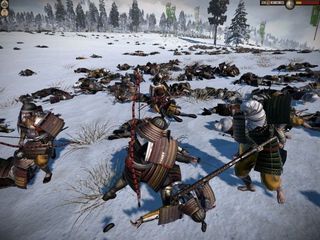Our Verdict
A generous, history-respecting rethink that adds weeks of fun to one of 2011s finest strategy titles.
PC Gamer's got your back
Should a Total War: Shogun 2 supplement centred on the Genpei War of 1180-1185 feature a comprehensive selection of period units? Before you answer with an eager 'Hai!' bear in mind that the Minamoto clan won the pivotal Battle of Kurikara with the aid of stampeding oxen.
There are no war cows in Rise of the Samurai, in fact this expansion is free of gimmicky bullocks/bollocks of all kinds. What you get for your very reasonable six quid is a cartload of new content that leaves Shogun 2 feeling sushi-fresh.
At the heart of the transformation is a corker of a campaign involving six pleasingly distinct and enticingly unfamiliar playable clans (see Pushy Bushi). Vying for control of a re-regioned Japan map, these clans have their origins in three different families, meaning you always start out with one powerful ally nearby. The blood ties between you aren't indestructible, but the relationship usually lasts long enough to give those early years of expansion a comforting co-op feel.

If sister clans sent the occasional “Prepare yourself. I'm about to attack those swines in the east!” missive, and were a bit more attentive when it came to mutual defence, that feeling of companionship would have been even stronger. On a couple of occasions I've watched my empire crumble before my eyes while sizeable allied armies in neighbouring provinces sat around gassing on their camping stools.
On the battlefield those armies look a lot more rustic and realistic than their base-game equivalents. The 400-year rewind brings a slightly simpler unit mix and far less fancy metal armour and flamboyant pageantry. Ashigaru and matchlock units are out. Cavalry is rarer. Formations are smaller and airier.
As the title of this supplement suggests, versatile bow-and-katanaarmed foot samurai are the new skirmish stars. The only units capable of poaching their limelight are the knots of club-wielding Tetsubo monks and the whitefaced, warhorse-spurring Onna Bushi heroines.

Women contribute to the war effort as sly Shirabyoshi, too. These traditional entertainers use poetry, dance, and, presumably, cuddling [Tim, we really need to have a chat - Biology Ed] to persuade enemy generals to defect and friendly ones to stay loyal. Picture how crestfallen The Creative Assembly's cutscene team must have been on being told agent animations wouldn't feature in this expansion.
Shirabyoshi share the agent mess room with Metsuke-like Junsatsushi, the Ninja-esque Monomi, and the rabble-rousing Sou. None of these strat-map wanderers are radically different from their Shogun 2 prototypes, but there are enough variations to encourage fresh approaches. Currently I'm playing as the well-heeled Hiraizumi and doing most of my conquering bloodlessly via the Junsatsushi 'switch allegiance' ability. First the agent spends a few turns passively influencing the target region, then a bulging carrier-bag of cash is handed over, and – bingo – the region usually switches sides. It's a very effective tactic. Perhaps too effective.

New agents are hired through such new structures as the barter house. To unlock these, Rise of the Samuraispecific arts trees must be climbed. Don't let anyone tell you this DLC is a lazy cash-in. Creative Assembly have thoroughly Genpei-fied almost every aspect of the game.
One of the few areas that hasn't felt the wind of change is the historical battle folder. Anegawa, the one previously unseen scrap, is a Sengoku-era affair.
Crawley's finest are already hinting that they've more Shogun 2 adjuncts up their voluminous kimono sleeves. If the coming packs are as full-featured, historically sensitive, and as transformative as Rise of the Samurai, then hang onto your Hattoris, we're in for a treat.
A generous, history-respecting rethink that adds weeks of fun to one of 2011s finest strategy titles.

